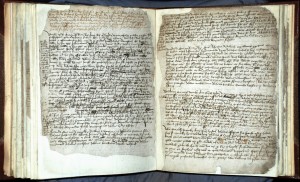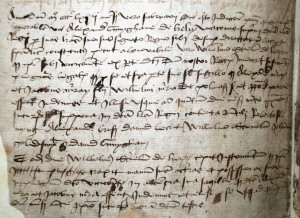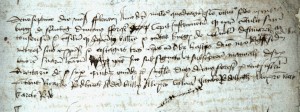
Stirling has the oldest Protocol Book in Scotland in its Archives, an unparalleled record of late mediaeval life in the central Scotland area. A Protocol Book is the record of the deeds and agreements made by people and witnessed by a Notary Public. The Notary Public was an official, usually with a clerical background, who had the job of setting down a written record of transactions. This volume is a written record used as reference by the Notary of his work.
Sir James Darow was a Notary Public by Royal appointment and by act of the Holy Roman Emperor. This gave him the power to make ‘Instruments’, written statements of fact that had ‘faith in law’ or that would be upheld by the legal process. These Instruments could be about ‘any lawful or honest business’ and this is reflected in the protocols that are recorded in this remarkable volume.
This volume is held as part of the records of Stirling Council because the Provost and Councillors of the Burgh of Stirling used James Darow as their Notary Public. Consequently, the volume is full of the enactments of the Council at this time, mostly relating to sales of land and property through documents known as sasines. This includes the first written reference in existence to the Provost of Stirling, at this time one Matthew Forrester. His name is given as witness to sale of a tenement in Stirling on the 23rd of January 1470/71. (At this time the New Year was not celebrated until the 25th March so dates between January and this date in March are always given using both years to make them clear.)

James Darow was also used as a Notary by a variety of other individuals throughout central Scotland so this volume gives all sorts of wonderful detail about life in Scotland in the late 15th century.
There are entries relating to marriage contracts indicating that marriages were arranged to further the property interests of the families concerned. For example, the agreement made on the 1st of January 1473/74 between Adam Cosour, Burgess of Stirling and his wife Katharine, and Robert Schaw of Muntoun by which the said Robert agrees to marry Janet Wrycht, widow of the late David Cosour, presumably to protect Cosour family interests. There is a sense of haste in the marriage of Duncan Aquhonam and Agnes Makcalpyn. The Notary records that they appear before him to make an agreement to be married on the 14th November 1475 and the marriage is recorded as having been solemnised on the following day. At the ceremony, two men, William Stewart and Malcolm McClory swear an oath that Duncan is old enough to marry. On the 4th May, Duncan Thomson ‘plighted his faith’ to give his prospective spouse one of his tenements to hold for her lifetime after they have married. One can only assume that it was only under this provision that she would marry him and that she wanted a record to be made so that she could hold him to the promise. Promises are the subject of an entry from the 17th February 1470/71 in which Ellen Lyne, widow of the late Gilbert Goldsmyth gave her oath before the high altar in the Parish Church of the Holy Rude, Stirling, that John Giles never made obligation to her anent a contract of marriage. This illustrates the very serious business that a breach of contract of marriage could be at this time.
Some of the entries reflect what an unsettled and turbulent time the late 15th century was for the people of central Scotland. The Scottish King, James III, was experiencing periods of unrest and upheaval owing to opposition from some of his nobility to his pro-English policies of the 1470s and problems relating to the continuing ambition of his brother, Alexander, Duke of Albany, to take the crown for himself. As a result, there was a general sense of unrest and lawlessness at this time.
On the 22nd January 1471/72, Duncan Nelson obliges himself not to trouble Margaret Blak ‘in her person or goods’. One can only presume that the ‘trouble’ was sufficient for Margaret to seek a legal solution to her problems. On the 4th February 1472/73, Alexander Cunyngham, the King’s Sheriff asked William Strivelin [Stirling] of Keyr [Keir] to ‘find sufficient pledges’ to guarantee the safety of Alexander and James Murray, sons of William Murray of Polmaise, until the 5th of March in the following year. William Strivelin ‘took instruments’ that the two Murray sons would remain unharmed by him until the date stipulated. On the 24th November 1473, Thomas, Lord Erskine and Alexander Erskine, his son, engaged not to molest Sir Richard Cristison and Andrew Cristison, both described as ‘Chaplains’. On the 22nd January 1475, Alexander Setoun of Tullibody offered assythement, that is, a compensation payment, to Alexander Cosour for the ‘slaughter’ of the late Robert Cosour. Violent times indeed.

Gifts and the public expression of gratitude are also recorded by the Notary Public. On 8th January 1470/71, Thomas Bully, Canon of the Cathedral Church of Glasgow gives all his goods to Duncan Bully, Canon of Aberdeen because the said Duncan is giving lodgings in Stirling High Street to Henry, Abbot of Dunfermline who had previously done ‘good deeds’ for Thomas. On the 23rd October 1476, Malize, Earl of Menteith gifted his wife, Lady Jonet, Countess of Menteith a silver gilt horn and other items in recognition of ‘the good deeds done to him…in England and Scotland’ by her.
The resolution of arguments about agreements are also occasionally illustrated such as in the entry dating from 4th May 1474, a disposition given by Robert Wrennock on his deathbed that he and Thomas Hammys, Mason, were present when the late Thomas Baker and Henry Greg agreed about the building of a stone stair.
Some entries indicate superstitious beliefs such as the Instruments taken by James Nory of Tarbert on the 19th May 1480 that the mother of a certain man ‘now dead’ publicly declared that by the instigation of ‘an evil spirit’ he had drowned himself in the River Teith and not through fault of the said James. Similarly, on the 26th May 1480, Thomas Prestoun took Instruments in the production of testimonial letters to Mr John Moffat, Official of Dunblane, on the purgation of a certain woman accused by her husband of sorcery.
The local response to royal requests for men and arms under the feudal system is illustrated in an entry of 17th February 1482/83 in which Duncan Forestar took Instruments that he had given his consent that the Provost and Bailies of Stirling should destine or provide three knights with three spears for the King at Edinburgh. This was just after the events of 1482 when King James III was imprisoned in Edinburgh Castle by his half uncles, and his brother, the Duke of Albany was responsible for bringing an English army into Edinburgh. At this time the King was seeking to reconsolidate his leadership of Scotland and about to call a Parliament to sit in Edinburgh and may have felt the need for more armed men to support him there. So here the local record reflects national concerns.

This marvellous volume is a true gem in the collection held at the Council Archives, both fascinating and important as a vital piece of evidence that holds huge significance to the people of this area and of Scotland as a whole.